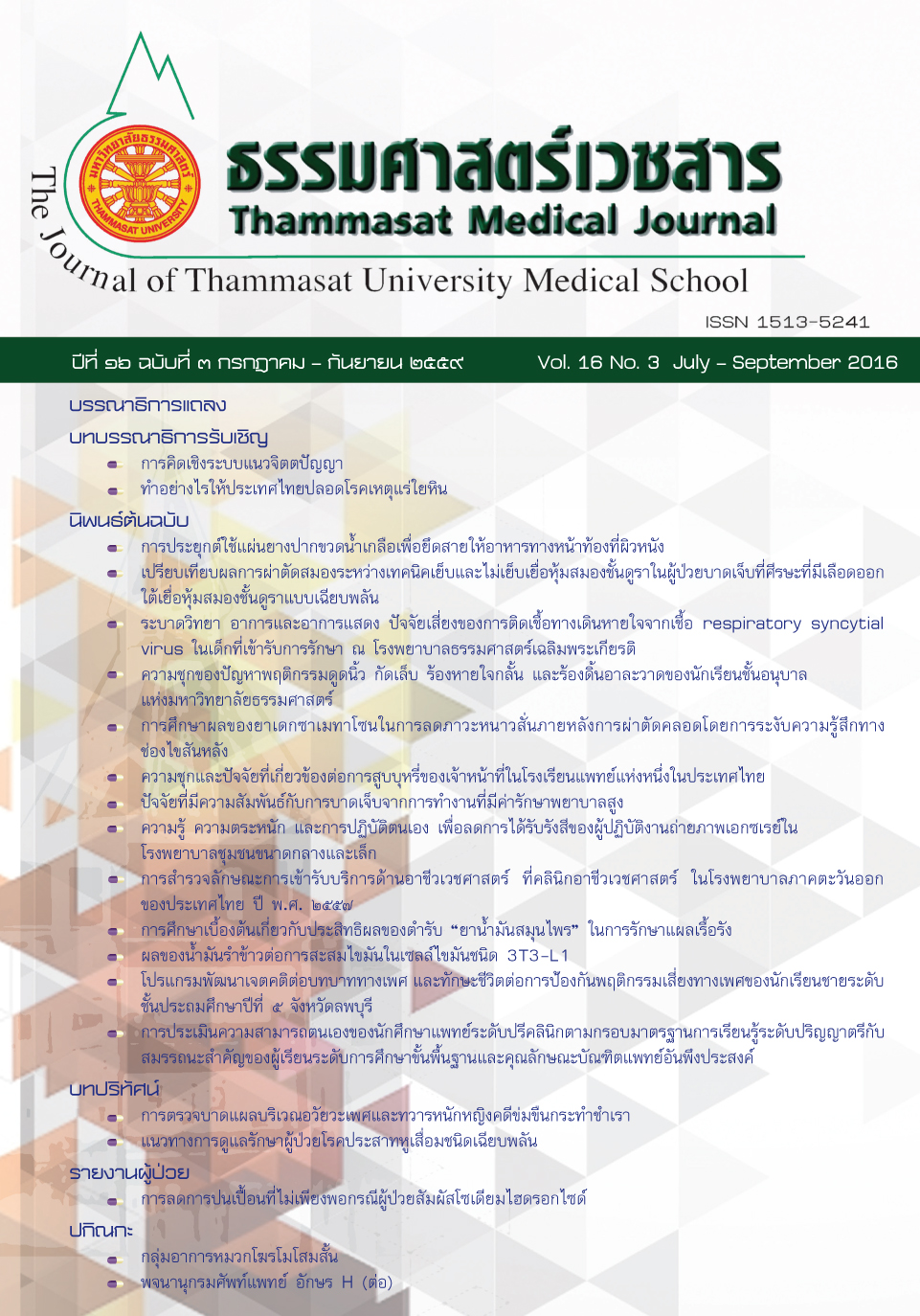Preliminary study of therapeutic efficiency of herbal oil remedy in chronic wound healing
Keywords:
Chronic wound-healing, Wound-healing herbal oil, “Thongnoppakun” herbal oil, แผลเรื้อรัง, น้ำมันสมุนไพรรักษาแผล, น้ำมันสมุนไพรทองนพคุณAbstract
Introduction: “Thongnoppakun” herbal oil has traditionally been used for chronic wound healing and is registered as herbal remedy for external use. The recipe is composed of coconut oil, sesame oil, Curcuma longaL., Allium sativum L., Acacia catechu Willd. and other plants. No scientific proof revealed about theefficiency of this remedy. Objective was to assess the therapeutic effectiveness of “Thongnoppakun”herbal oil as a wound-healing remedy.
Method: Eight patients with chronic wounds at critical severity level were included using Before-After model. Wounds were dressed 2 times/day with normal saline, dried with clean cotton, dressed herbal oil and closed with gauze patch. The outcomes of wound appearances, ranking scales of 1 to 5, were evaluated every 2 weeks for 8 weeks according to Bates-Jensen Wound Assessment Tool (BWAT). Score 5 means the highest severity level. The score in each item was analyzed by one-way ANOVA and compared to the beginning by using LSD multiple comparison.
Result: Three patients died due to the original diseases. The chronic wounds of the remaining 5 patients were analyzed. Three groups of symptoms (1. edges, necrotic tissue amount, exudate types; 2. undermining and epithelial and 3. exudate amount, skin color surrounding wound, granulation and total scores) were significantly different at the 0.05, 0.01 and 0.001 levels in the 6th and 8th week of treatment. Severity level changed from critical to moderate and mild in the 4th and 8th week.
Discussion and Conclusion: “Thongnoppakun” herbal oil showed potential value as an external dressing for chronic wounds within the 6th week after treatment. These results conform to Thai traditional medicine hypothesis of wound causes and treatment with the herbal oil. For statistical validity, at least 5 more patients should have been included in this clinical trial.
บทนำ: การรักษาแผลเรื้อรังด้วยวิธีทางแพทย์แผนไทย ยาน้ำมันรักษาแผลทองนพคุณ เป็นยาน้ำมันสมุนไพรสำหรับรักษาแผลเรื้อรังที่ได้พัฒนาจากตำรับยาประจำตระกูลของแพทย์แผนไทยและได้ขึ้นทะเบียนเป็นยาสมุนไพรรักษาแผลภายนอก ยาน้ำมันสมุนไพรนี้ประกอบด้วยตัวยาสำคัญ ได้แก่ น้ำมันมะพร้าว น้ำมันงา ขมิ้นชันกระเทียม สีเสียดไทย และอื่นๆ ปัจจุบันยังขาดข้อมูลการติดตามการวัดประสิทธิผลการรักษาในผู้ป่วยแผลรื้อรังตามหลักการทางวิทยาศาสตร์
วิธีการศึกษา: รูปแบบการศึกษาแบบวัดผลก่อนและหลังการทดลอง (Before-After model) ในผู้ป่วยที่มีแผลเรื้อรังระดับรุนแรงจำนวน ๘ ราย ผู้ป่วยได้รับการรักษาแผลตามขั้นตอนมาตรฐานการทำแผล ทายาน้ำมันสมุนไพรและปิดแผล วันละ ๒ เวลา จากนั้นในสัปดาห์ที่ ๒, ๔, ๖ และ ๘ ผู้วิจัยทำการวัดผลโดยใช้เครื่องมือการประเมินการหายของแผลของ Bates-Jensen Bates-Jensen Wound Assessment Tool (BWAT) ซึ่งมีค่าความเชื่อมั่นของเครื่องมือ (reliability of tools) เป็น ๐.๙๑ ประเมินลักษณะแผลและให้คะแนน ๑ - ๕ เป็นระดับความรุนแรงน้อยสุดถึงวิกฤต คำนวณสถิติด้วยวิธี ANOVA และ LSD
ผลการศึกษา: ผู้ป่วย ๘ ราย เสียชีวิตด้วยโรคที่เป็น ๓ ราย ผู้ป่วย ๕ ราย มีแผลกดทับที่มีระดับความรุนแรงขั้นวิกฤก่อนรักษาหลังการรักษาพบว่าแผลมีระดับความรุนแรงลดลงเป็นระดับปานกลางและระดับน้อยในสัปดาห์ที่ ๔ และ ๘ จากการประเมินลักษณะของแผล ๓ ประเด็นได้แก่ ๑. ขอบแผล ลักษณะเนื้อเยื่อตาย ลักษณะสารขับหลั่ง ๒. ความลึกของโพรงใต้ผิวหนัง ๓. ปริมาณสารขับหลั่ง สีของผิวหนังรอบแผล เนื้อเยื่องอกทดแทนทั้ง ๓ ประเด็นนี้มีอาการดีขึ้นแตกต่างจากก่อนรักษาอย่างมีนัยสำคัญในสัปดาห์ที่ ๖ และ ๘ ค่า p น้อยกว่า ๐.๐๕, ๐.๐๑ และ ๐.๐๐๑ ตามลำดับ
วิจารณ์ และสรุปผลการศึกษา: จากข้อมูลที่ประเมินเบื้องต้นนี้สรุปได้ว่า ยาน้ำมันสมุนไพรทองนพคุณ มีประสิทธิผลในการรักษาแผลเรื้อรังระดับวิกฤตได้ผลดีขึ้นในสัปดาห์ที่ ๖ อีกทั้งผลการศึกษานี้สอดคล้องกับการแพทย์แผนไทยเกี่ยวกับสมมติฐานการเกิดแผลและการรักษาแผลด้วยตัวยาสมุนไพรในตำรับนี้ เพื่อความสมบูรณ์ทางสถิติของงานวิจัย ควรเพิ่มจำนวนผู้ป่วยอีกอย่างน้อย ๕ ราย



